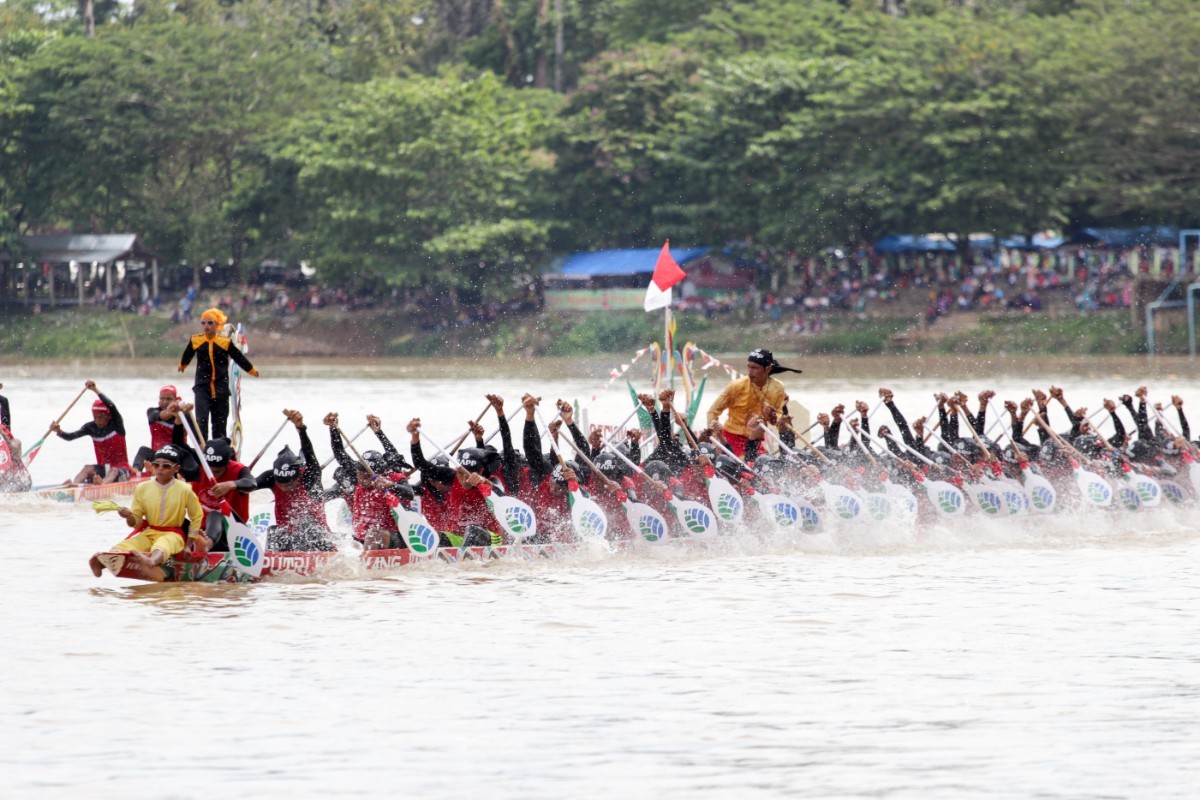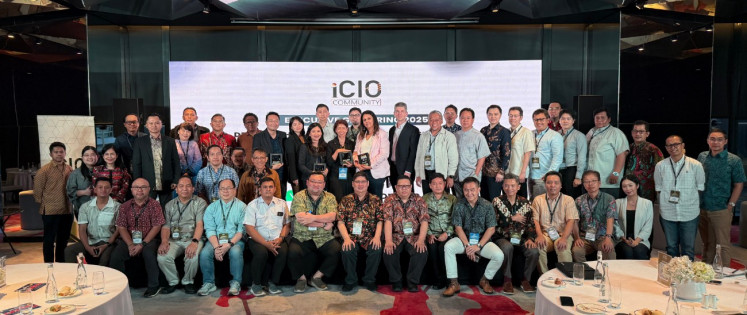Popular Reads
Top Results
Can't find what you're looking for?
View all search resultsPopular Reads
Top Results
Can't find what you're looking for?
View all search resultsPacu Jalur Festival showcases Riau’s rich culture and beauty
Isparianto was just one of thousands of interested spectators who had come from surrounding areas to watch the boat races of the 2018 Pacu Jalur Festival.
Change text size
Gift Premium Articles
to Anyone
Rizal Harahap
The Jakarta Post, Pekanbaru
Isparianto was just one of thousands of interested spectators who had come from surrounding areas to watch the boat races of the 2018 Pacu Jalur Festival.
Speaking at the festival’s boat race course, known as Tapian Narosa, near the town of Teluk Kuantan in Kuantan Singingi regency, Riau, Sumatra, the father of two said: “I think this is a really interesting tradition. Many locals who work in other parts of the country come home just to see this event”.
“As you can see, there are so many people here. This is just like a holiday festival. Many decided not to make a homecoming journey during Idul Fitri, and instead scheduled a trip home during this festival,” he added.
This year, as in other years, the competition lasted for four days, from Aug. 29 until Sept. 1. But, in Teluk Kuantan, a festive atmosphere could be felt a week before the festival officially kicked off. All accommodation in the town was fully booked, with visitors coming in not just from nearby regions, but also from outside the province. Not all visitors were in town for the boat race – many were seasonal traders hoping to make a profit.
“Each year, I sell clothes here. People from far and wide descend on the town, and it comes alive for 24 hours during the Pacu Jalur event. There are many entertaining activities, making this truly a folk festival. It would be a huge loss to miss out on this, and we traders always keenly await the festival,” said Edison, a citizen of Padang Panjang, West Sumatra, who rented a stall near the Teluk Kuantan night market.
For Kuantan Singingi locals, the month of June marks the beginning of Pacu Jalur fever. Each village usually prepares their team for a district-level race. The champion from each district will then go to Tapian Narosa for the Pacu Jalur race, which offers a significant cash prize. Last year, the first finisher received Rp 65 million in development money, the second got Rp 55 million and the third won Rp 45 million.
This year, 182 jalur (boats) competed at Tapian Narosa. Participants also came from other regencies and towns in Riau to compete with the home team. Indragiri Hulu regency sent 22 jalur, and boats also came from Siak regency, Indragiri Hilir Hulur, and the city of Pekanbaru.
The Pacu Jalur Festival earned the title of the most popular tourist festival at Anugrah Pesona Indonesia 2017. The festival is also one of the three international events from Riau to be included on the 2018 list of 100 Events in Wonderful Indonesia, released by the Tourism Ministry. The local government hopes the festival can help make Kuantan Singingi regency a popular tourist destination in Riau.
Aside from the boat race, the event also featured a folk festival where various local cultural and art performances took place. This year, 10 Randai dance groups from different districts performed over the four days. There were also culture nights held on three different evenings, attended by representatives from all regencies and towns in Riau, as well as visitors from Padang Pandang in West Sumatra province.
The jalur has been used by the people of Kuantan Singingi since the 17th century. The story goes that the long boat was the main means of transportation along the Kuantan River. Measuring between 25 and 35 meters, and around 1.5 meters wide, each jalur can accommodate hundreds of kilograms of crops or carry up to 50 passengers.
The jalur are used for racing at special events, such as those for harvest or on religious holidays, like Lebaran. In 1903, a Pacu Jalur race was held to celebrate the birthday of Queen Wilhelmina, then the ruler of the Netherlands, on Aug. 31. This moment is recognized as the beginning of the Pacu Jalur Festival.
After Indonesia’s independence, the Pacu Jalur Festival became a way of commemorating Independence Day. In the race, two jalur race along a course heading downstream. The competition is based on a knockout system so, on the last day, the final two jalur race for the title.
At a glance, jalur look similar to other wooden boats. But the process of making them is special. It is a sacred process, involving all villagers. That’s why if a village wants to build a jalur, the villagers will establish a special committee with members selected by general consensus.
The jalur builder is said to possess a mystical power. This is believed to be necessary as the process of picking the wood in the forest, and then the carving process, are accompanied by specific rituals designed to ward off evil spirits. The wood used to build the boat is usually kure, or banio wood, characterized by its light weight, straight and long form, and water-resistant quality.
After the initial carving is done in the forest, the villagers work hand in hand to drag the half-made jalur to the village. They do this using a long rope. Young unmarried men and women of the village take part in the venture, which has been known to be a way for many of them to get to know each other, and even find a future spouse.
After the finishing process in the village, the jalur is painted in different colors and accessorized with a carving at the stern. A night-long traditional ceremony includes “washing” the long boat with fire, a series of traditional performances, like the Randai dance, and a communal meal. After the building process, which can take months, the jalur gets a name that the villagers must agree on. Only then is the boat ready for the competition.
To most, the competition is a race to find out which jalur is the fastest. The people of Kuantan Singingi, however, believe the Pacu Jalur is a competition between pawing (shamans) to prove who has the strongest mystical powers. Today, many still believe the shaman plays a very big role in the race.
Kuantan Singingi Regent Mursini said he was proud that some Pacu Jalur rowers had grown to become international athletes. “Riau province sent six rowing athletes to represent Indonesia at the 2018 Asian Games. Four of them are from Kuantan Singingi regency. They won two silver medals and one bronze medal for Indonesia. Hopefully more youths from Kuantan Singingi can go on to become national athletes,” he said.
When officially opening the 2018 Pacu Jalur Traditional Festival, Riau Governor Arsyadjuliandi Rachman said the event had a domino effect on the regional economy because it enticed more tourists to visit.
“Pacu Jalur is a 115-year-old festival. This event is the oldest in Indonesia and it is a tradition that is still alive and well in this modern era. Pacu Jalur supports the concept of Riau developing itself as a culture-based tourist destination.
“Riau has a rich heritage of materials and non-material assets, recognized by the Education and Culture Ministry. We hope that the culture-based tourism concept, and the four big rivers in Riau, can help us draw more tourists to visit the region,” he said.
The governor also said that, in the last few years, the tourist industry in the province had continued to grow, having a notable impact on the local economy. “The food and creative economy sectors, and transportation and accommodation, have grown well. I am sure at least 300,000 people come here for the competition. This is incredible,” he said.
Today, fewer forests in Kuantan Singingi have trees with the wood that is used to build the boats. As a result, a community elder of Kuantan Singingi, Edyanus Herman Halim, asked the government to take action to help preserve the Pacu Jalur tradition. He asked that the government designate a forest area for jalur making in 15 districts in Kuantan Singingi.
“Three hectares per district is enough. It will mean that 45 hectares are allocated in total. Whether the tradition lives on depends on the availability of the trees to build jalur,” he said.
He added that the tradition needed to continue to exist because it carried many cultural values that had continued to grow. “This activity unites the people. The aspect of mutual cooperation that Pacu Jalur teaches us is a reflection of the spirit of togetherness among people to achieve common goals,” he said.
“This culture wasn’t brought here from anywhere. It was born out the locals’ tradition of interacting with nature and the environment. This is what we are bringing to life through sport.”
Edyanus said the growing popularity of the Pacu Jalur Festival meant that the culture and values represented by the event needed to be protected. “We have to uphold the dignity of our customs and our culture. All parties – the participants, spectators and the government – should help nurture the noble values contained in this activity,” he said.
“The philosophy we can directly learn from Pacu Jalur is the harmonious division of duties to achieve mutual goals. In the boat, the Tukang Onjai manages the rhythm of the Jalur’s forward motion with his music. The Tukang Tari must be able to manage the steering of the jalur against the other team.”
“The Tukang Lopak has to make sure water doesn’t flood the floor of the boat. The Tukang Kemudi, as the helmsman, should make sure the boat follows the correct path. And all Tukang Kayuh, or the rowers, have to work to get the boat to the finish. All elements must work in harmony and all must be committed to giving all their energy and skills till the end.”
Even though the target is to win the race, he said everyone involved in the festival should make the event a true festival to bring happiness and nurture the spirit of brotherhood. “We shouldn’t put winning the title and competition as the main objectives. Winning and losing are normal,” he said.
Edyanus said he was thankful to all parties that had provided moral and material support to ensure the success of the festival. “On behalf of Kuantan Singingi, we want the government and those in the business sector to remain active in promoting the Pacu Jalur race, so that it will stay with us, and so the people can still enjoy it,” he said.
Wan Mohd Jakh Anza, the general manager of stakeholder relations at PT Riau Andalan Pulp and Paper (RAPP), said his company was committed to making the Pacu Jalur Festival a success. The company contributed Rp 300 million to the event and provided transportation and clothes for the committee. The pulp and paper producer also sponsored four jalur from four of the villages participating in the festival.
“This shows RAPP’s commitment to the culture and values that the people of Riau hold dear, which is perfectly represented by the Pacu Jalur Festival. This event is the pride of everyone here. We are actively participating because RAPP, as our philosophy states, is here not as a guest. We want to support the community in which we operate,” he said.










